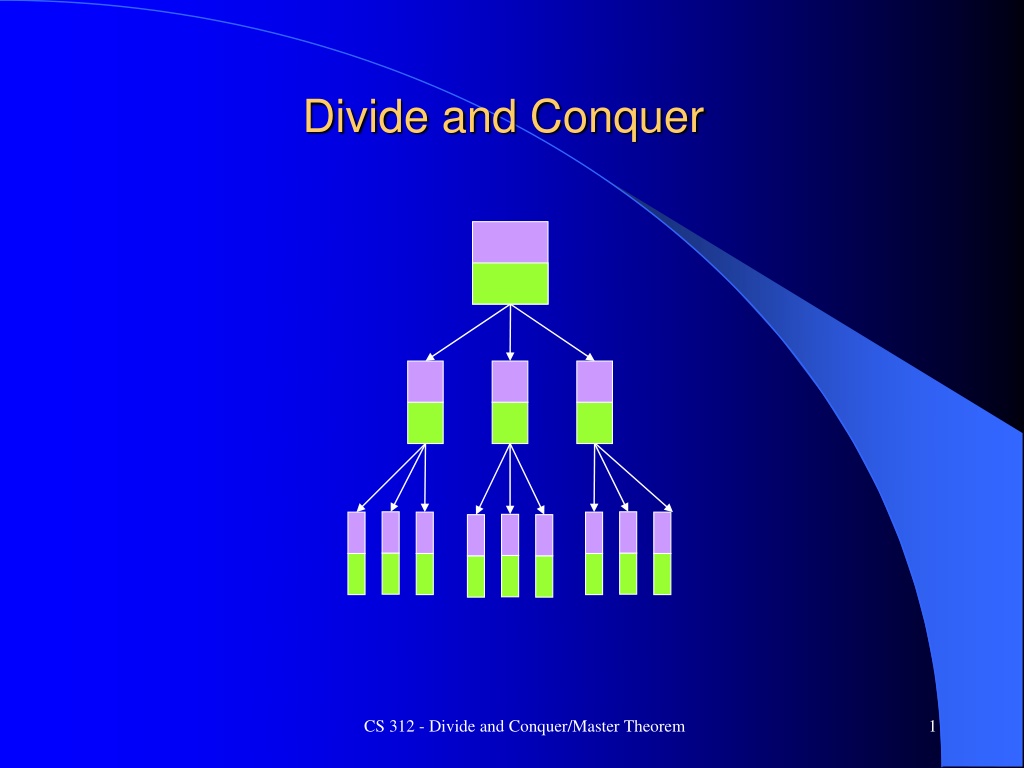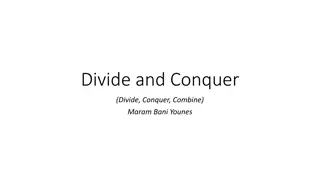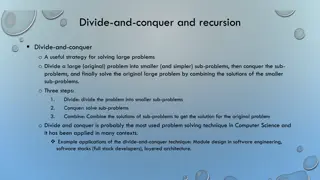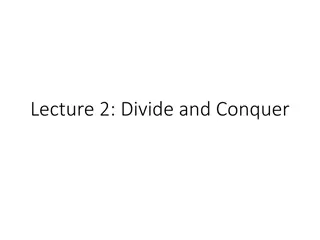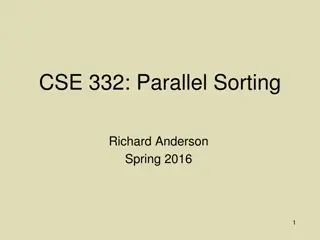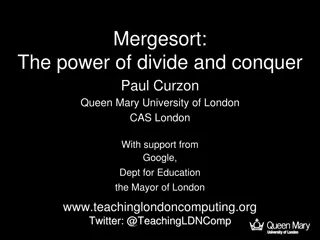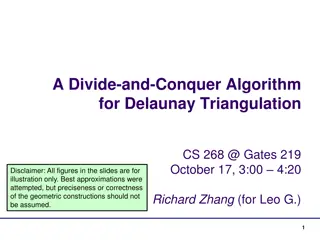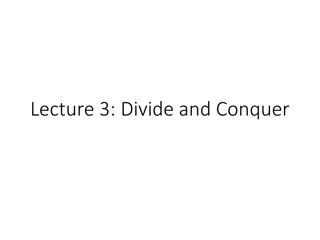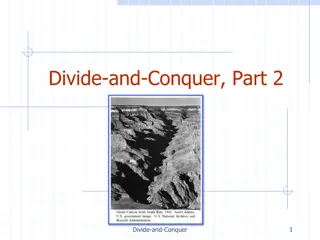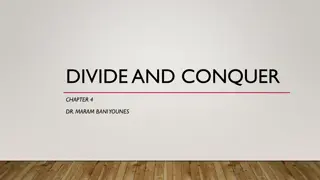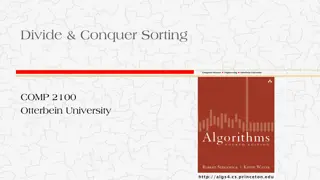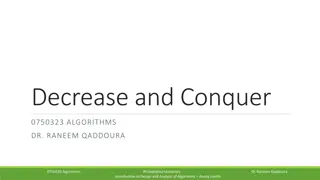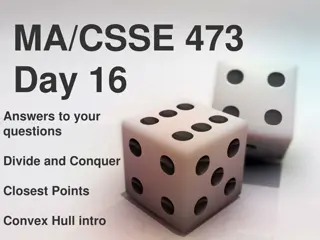Understanding the Divide and Conquer Technique in Computer Science
The Divide and Conquer approach is a powerful strategy used in computer science to break down large problems into smaller, more manageable subproblems. By recursively solving these subproblems and combining their results, this technique offers a structured way to tackle complex tasks efficiently. This method partitions tasks, solves them recursively, and merges the solutions, resulting in potential speed-ups for problem-solving processes. The approach involves splitting problems into smaller instances, solving them, and then combining the results to address the original problem effectively.
Download Presentation

Please find below an Image/Link to download the presentation.
The content on the website is provided AS IS for your information and personal use only. It may not be sold, licensed, or shared on other websites without obtaining consent from the author. Download presentation by click this link. If you encounter any issues during the download, it is possible that the publisher has removed the file from their server.
E N D
Presentation Transcript
Divide and Conquer CS 312 - Divide and Conquer/Master Theorem 1
Divide and Conquer Algorithms 1. Partition task into sub-tasks which are smaller instances of the same task 2. Recursively solve the sub-tasks Each sub-task often only solved outright when the bottom (threshold) of the recursion is reached 3. Appropriately combine the results Why Divide and Conquer? Can be an easier way to approach solving large problems Can be faster - but not always Critical point! Some examples coming CS 312 - Divide and Conquer/Master Theorem 2
Divide and Conquer Structure logn depth At each level split current problem (size n) into smaller subproblems Depth O(logn) depends on how we split and potential overlap in splits Do not always need to split all the way to one element per leaf, but often do Number of leaf nodes my be smaller or greater than n Possible combining/merging on the way up Actual problem solving work may be done at split time, at the leaf nodes, at combine time, or any combination of these three Efficiency gains occur if the problem solving work can be simplified because of the split/merge paradigm CS 312 - Divide and Conquer/Master Theorem 3
Grading n exams logn depth Non DC time required? nG where G is time to grade 1 exam: O(n) CS 312 - Divide and Conquer/Master Theorem 4
Grading n exams logn depth Non DC time required? nG where G is time to grade 1 exam: O(n) Divide and Conquer? Feels more manageable, etc. Any overall speed-up on exam grading? CS 312 - Divide and Conquer/Master Theorem 5
Grading n exams logn depth Non DC time required? nG where G is time to grade 1 exam: O(n) Divide and Conquer? Feels more manageable, etc. Any overall speed-up on exam grading? No. Although note potential parallelism Some overhead to split (dividing) and combine (re-stacking) the exams n splits each being O(1) gives O(n) but splits are very fast operations compared to G Divide and conquer version still O(n) CS 312 - Divide and Conquer/Master Theorem 6
Sorting n Integers logn depth Non DC time required? CS 312 - Divide and Conquer/Master Theorem 7
Sorting n Integers logn depth Non DC time required? n2using some bubble sort variation: O(n2) Divide and Conquer? Splitting is fast just like for grading exams O(n) No work at leaves Each leaf is an "ordered" list of length 1 to return Now we have n ordered lists of length 1 at the leaves Fast to do (O(n)) but was it worth it? CS 312 - Divide and Conquer/Master Theorem 8
Mergesort Example CS 312 - Divide and Conquer/Master Theorem 9
Sorting n Integers logn depth Combining requires a merge of two ordered lists which is O(n) compared to the O(n2) required to sort one list directly. The key to the speedup!! Note that at the first combination the lists are of length one so it is a O(1) merge, but there are n/2 of those merges at the level, which adds up to a total of O(n) work at that level The lists double in size each level up, but the number of merges halves, so the work stays O(n) Divide and conquer version is O(n) at each of the log(n) levels for total of O(nlog(n)) CS 312 - Divide and Conquer/Master Theorem 10
DC Multiply can we beat n2? 5218 * 4376 How do we do divide and conquer with multiply? CS 312 - Divide and Conquer/Master Theorem 11
DC Multiply can we beat n2? Assume x and y are n-bit binary numbers and n is a power of 2 Back to considering n as length of number for a moment Power of 2 is not essential, just makes explanation easier First split x and y into halves n/2 bits long: xL, xR, yL, yR x y = (2n/2xL + xR)(2n/2yL + yR) = 2nxLyL + 2n/2(xLyR+ xRyL) + xRyR x y = 10nxLyL + 10n/2(xLyR+ xRyL) + xRyR (Decimal version) 5218 * 4376 = (5200 + 18) * (4300 + 76) = 100*52*43 + 10*(52*76 + 43*18) + 18*76 CS 312 - Divide and Conquer/Master Theorem 12
DC (Divide and Conquer) Multiply x y = 2nxLyL + 2n/2(xLyR+ xRyL) + xRyR x y = 10nxLyL + 10n/2(xLyR+ xRyL) + xRyR (Decimal version) 5218 * 4376 52 * 76 18 * 76 52 * 43 18 * 43 5 * 4 5 * 3 2 * 4 2 * 3 1 digit multiply at leaves. Each is O(1). No multiplies when we go back up the tree, just shifts and adds CS 312 - Divide and Conquer/Master Theorem 13
DC (Divide and Conquer) Multiply x y = 2nxLyL + 2n/2(xLyR+ xRyL) + xRyR x y = 10nxLyL + 10n/2(xLyR+ xRyL) + xRyR (Decimal version) 5218 * 4376 52 * 43 = 2236 2000+150+80+6=2236 52 * 76 18 * 76 52 * 43 18 * 43 15 6 8 20 5 * 4 5 * 3 2 * 4 2 * 3 1 digit multiply at leaves. Each is O(1). No multiplies when we go back up the tree, just shifts and adds CS 312 - Divide and Conquer/Master Theorem 14
DC Multiply x y = 2nxLyL + 2n/2(xLyR+ xRyL) + xRyR 1 multiply becomes 4 smaller multiplies Each multiply just a recursive call until leaves are reached No multiplies needed on the way up, just shifts and adds O(n) Since branching factor is 4, the # of leaf nodes is 4depth = 4log2n = nlog24 = n2 (alogbn = nlogba ) Work at each leaf node is always O(1) since no longer dependent on n Just do the O(1) multiply at each node getting 1 or 0 for binary n2 leaf nodes each with O(1) complexity gives a total leaf level complexity of O(n2) What is complexity at next level up? n2/4 nodes doing 2 bit adds and shifts Thus next level up is n2/2. Total work decreases by at each level up What is root level Complexity? CS 312 - Divide and Conquer/Master Theorem 15
DC Multiply Complexity x y = 2nxLyL + 2n/2(xLyR+ xRyL) + xRyR Root level complexity is n, just adds and shifts and complexity increases by 2 at each level Leaf level complexity is n2 (number of leaf nodes) Total complexity is n + 2n + 4n + 8n . + n n < 2n2 Total complexity of all the internal nodes of the tree is less than the leaf level in this case Thus, from the root the complexity is a geometric series from n to n2 which increases by a factor of 2 at each level (geometric ratio = 2). Thus, the complexity is equal to that of the leaf level, O(n2). CS 312 - Divide and Conquer/Master Theorem 16
Intuition: Geometric Series Geometric series Assume f(n) = 1 + c + c2 + ... + cn if c < 1 then each term gets smaller and f = (1), the first term example: if c=.5, then 1 + 1/2 + 1/4 + ... + 1/2n < 2 if c > 1 then f = (cn), which is the last term example: if c=2, then 1 + 2 + 4 + 8 + + 2n < 2 2n and is (2n) if c = 1 then 1 + 1 + 1 + 1 + + 1 = n andf = (n) We can replace the 1 above with any function g(n) Assume f(n) = g(n) + cg(n) + c2g(n) + ... + cng(n) if c < 1 then each term gets smaller and f = (g(n)), the first term example: if c=.5, then g(n) + g(n)/2 + g(n)/4 + ... + g(n)/2n < 2g(n) Could do same with c > 1 and c = 1 examples above CS 312 - Divide and Conquer/Master Theorem 17
Intuition: Geometric Series Review Why isn't complexity n3 or n2logn? Important concept here! Geometric series (HW# 0.2) for c > 0 f(n) = 1 + c + c2 + ... + cn= (cn+1 - 1)/(c-1) if c < 1 then each term gets smaller and f = (1), the first term Since, 1 < f(n) = (1-cn+1)/(1-c) < 1/(1-c) example: if c=.5, then 1 + 1/2 + 1/4 + ... + 1/2n < 2 if c > 1 then f = (cn), which is the last term Since, (1/(c-1)) cn < cn < (c/(c-1)) cn example: if c=2, then 1 + 2 + 4 + 8 + + 2n < 2 2n and is (2n) if c = 1 then f = (n), why? Divide and Conquer tree analogy with complexity at levels For geometric series (c is the geometric ratio) If decreasing (ratio < 1) then complexity is (first term/root) If increasing (ratio > 1) then complexity is (last term/leaves) If unchanging (ratio = 1) then complexity is (n = number of terms/levels of tree CS 312 - Divide and Conquer/Master Theorem 18
A Key Takeaway logn depth Assume C(k) is the complexity (amount of work) at level k Rate of increase/decrease in work at each level is the geometric ratio If starting from top level C(k) is decreasing (ratio < 1), then the total asymptotic work will be equal to that done at the root node, since all the other work done at lower levels is within a constant factor of the top level If C(k) increases with depth k then the total asymptotic work will be equal to that done at the leaf (bottom) level, since all the other work done at higher levels is within a constant factor of the leaf level Just # of leaf nodes since n=1 at leaves, and thus each leaf node has O(1) complexity If C(k) is the same at each level, then total work is # of levels *C(k) # of levels is logn for divide and conquer, thus logn *C(k) CS 312 - Divide and Conquer/Master Theorem 19
Faster Divide and Conquer Multiply The product of 2 complex numbers is (a+bi)(c+di) = ac - bd + (bc+ad)i which requires 4 multiplications Carl Freidrich Gauss noted that this could be done with 3 multiplications (but a few more adds) because bc + ad = (a+b)(c+d) - ac - bd While this is just a constant time improvement for one multiplication, the savings becomes significant when applied recursively in a divide and conquer scheme Gauss trick CS 312 - Divide and Conquer/Master Theorem 20
Faster Multiply Let's use Gauss's trick: xy = 2nxLyL + 2n/2(xLyR+ xRyL) + xRyR xLyR+ xRyL= (xL+ xR)(yL+ yR) - xLyL- xRyR xy = 2n xLyL+ 2n/2((xL+ xR)(yL+ yR) - xLyL- xRyR) + xRyR Now have 3 multiplies rather than 4 But this savings happens at every branch of the recursion tree, 3- ary vs a 4-ary tree Key to speed-up in this case # of leaf nodes is 3log2n = nlog23 = n1.59 (alogbn = nlogba ) Thus time complexity in the tree is a geometric series from n to n1.59 increasing by 3/2 (ratio) at each level with the last term (leaf nodes) again dominating the complexity Complexity is O(n1.59) Improved complexity class Because we combined DC with Gauss trick to decrease tree arity Can we do an even faster multiply? - Yes FFT O(nlogn) CS 312 - Divide and Conquer/Master Theorem 21
Master Theorem The Master Theorem gives us a convenient way to look at a divide and conquer problem and quickly get the asymptotic complexity We cast the problem as a recurrence relation and the master theorem decides whether the complexity at each level is: Increasing: leaf level gives complexity which is just the number of leaf nodes Decreasing: root node gives complexity Same at each level: work at each level * number of levels (logn) CS 312 - Divide and Conquer/Master Theorem 22
Master Theorem t(n) = at( n/b )+O(nd) Given: Where a > 0, b > 1, d 0 and n = task size (variable number of elements) a = number of sub-tasks that must be solved per node n/b = size of sub-instances d = polynomial order of work at each node (leaf/partitioning/recombining) Then: This theorem gives big O time complexity for most common DC algorithms CS 312 - Divide and Conquer/Master Theorem 23
Master Theorem Examples t(n) = at( n/b )+O(nd) What is complexity of our 2 multiplication algorithms? First write recurrence relation, then apply master theorem CS 312 - Divide and Conquer/Master Theorem 24
Master Theorem Examples t(n) = at( n/b )+O(nd) What is complexity of our 2 multiplication algorithms? First write recurrence relation, then apply master theorem T(n) = 4T(n/2) + O(n), a/bd = 4/21 = 2 CS 312 - Divide and Conquer/Master Theorem 25
Master Theorem Examples t(n) = at( n/b )+O(nd) What is complexity of our 2 multiplication algorithms? First write recurrence relation, then apply master theorem T(n) = 4T(n/2) + O(n), a/bd = 4/21 = 2, O(nlogba) = O(nlog24) = n2 T(n) = CS 312 - Divide and Conquer/Master Theorem 26
Master Theorem Examples t(n) = at( n/b )+O(nd) What is complexity of our 2 multiplication algorithms? First write recurrence relation, then apply master theorem T(n) = 4T(n/2) + O(n), a/bd = 4/21 = 2, O(nlogba) = O(nlog24) = n2 T(n) = 3T(n/2) + O(n), a/bd = 3/21 = 1.5, O(nlogba) = O(nlog23) = n1.59 CS 312 - Divide and Conquer/Master Theorem 27
Master Theorem Examples t(n) = at( n/b )+O(nd) What is complexity of our 2 multiplication algorithms? First write recurrence relation, then apply master theorem T(n) = 4T(n/2) + O(n), a/bd = 4/21 = 2, O(nlogba) = O(nlog24) = n2 T(n) = 3T(n/2) + O(n), a/bd = 3/21 = 1.5, O(nlogba) = O(nlog23) = n1.59 Key to speed-up in divide and conquer is to find short-cuts during partition/merge that can be taken because of the divide and conquer approach CS 312 - Divide and Conquer/Master Theorem 28
Master Theorem Notes t(n) = at( n/b )+O(nd) What is a/bd: What is nlogba: Why no work done per node nd in leaf option? Why no log base in ndlogn option: If top node dominates then don t need to do rest of tree? CS 312 - Divide and Conquer/Master Theorem 29
Master Theorem Notes t(n) = at( n/b )+O(nd) What is a/bd: Geometric ratio of how work changes as we go down the tree What is nlogba:The number of leaf nodes Why no work done per node nd in leaf option? nd = 1 since each leaf does order 1 work given n=1 at leaf Why no log base in ndlogn option: Same big theta regardless of base If top node dominates then don t need to do rest of tree? No. nd is work done at that node given that we are doing DC including a constant factor amount of work going down the tree. Might not be that fast otherwise. CS 312 - Divide and Conquer/Master Theorem 30
**Challenge Question** - Master Theorem t(n) = at( n/b )+O(nd) Use the master theorem to give the big-O complexity of T(n) = 5T(n/3) + O(n3) T(n) = 4T(n/2) + O(n2) Binary Search CS 312 - Divide and Conquer/Master Theorem 31
Proof/Intuition of the Master Theorem For simplicity assume n is a power of b (only a constant factor difference from any n) Height of the recursion tree is logbn Branching factor is a, thus there are aksubtasks at the (kth) level of the tree, each task of size n/bk Total work at kth level is thus ak O(n/bk)d (#tasks (task size)d) = O(nd) (a/bd)k Work/level (geometric ratio)k Note that (a/bd)k as k goes from 0 (root) to leaf (logbn) is a geometric series with ratio a/bd. The geometric ratio a/bd shows to what extent work is increasing/decreasing at each level. The big-O sum of such a series is The first term of the series if the ratio is less than 1 k (number of terms in the series) if the ratio is 1 The last term of the series if the ratio is greater than 1 CS 312 - Divide and Conquer/Master Theorem 32
Master Theorem Example/Intuition Assume n = 4, a = 4, b =2 We'll consider d = 1, 2, and 3 total combining/pre-partitioning work at each node is O(n), O(n2), or O(n3) Total work at kth level is ak O(n/bk)d = #tasks (task size)d = O(nd) (a/bd)k = Work/level (geometric ratio)k Level Number of tasks ak Task size n/bk Total work at level k for d = 1 a/bd= 2 Total work at level k for d = 2 a/bd= 1 Total work at level k for d = 3 a/bd= .5 0 1 4 4 = 1 41 nd 16 = 1 42 64 = 1 43 1 4 2 8 = 4 21 16 = 4 22 32 = 4 23 2 = logbn 16 1 16 = 16 11 16 = 16 12 16 = 16 13 O(nlogba) = n2 # of leaf nodes work/leaf = nd = 1d O(ndlogn) = n2logn (work/level) #levels O(nd) = n3 Main complexity at root node CS 312 - Divide and Conquer/Master Theorem 33
Proof/Intuition of the Master Theorem t(n) = at( n/b )+O(nd) Total work at level k is ak O(n/bk)d = O(nd) (a/bd)k If a/bd< 1 (i.e. a < bd) then complexity is dominated by root node: O(nd) a/bd =.5: nd+ nd/2 + nd/4 ... nd/2logbn = nd(1 + 1/2 + 1/4 + ... + 1/2logbn) < 2nd If a/bd= 1 then all logbn levels of tree take equal time O(nd) giving a total complexity of O(ndlogn) if a/bd> 1 then complexity is dominated by the leaf level: nd (a/bd)logbn logbn alogbn (blogbn)d = nd alogbn nd a = nd = alogbn= a(logan)(logba)= nlogba bd nd CS 312 - Divide and Conquer/Master Theorem 34
Divide and Conquer - Mergesort Sorting is a natural divide and conquer algorithm Merge Sort Recursively split list in halves Merge together Master theorem does not do space complexity, which is usually n for divide and conquer, what is space complexity for Mergesort? Real work happens in merge - O(n) merge for sorted lists compared to the O(n2) required for merging unordered lists Tree depth logbn What is complexity of recurrence relation? Master theorem 2-way vs 3-way vs b-way split? CS 312 - Divide and Conquer/Master Theorem 35
Mergesort Example CS 312 - Divide and Conquer/Master Theorem 36
Convex Hull The convex hull of a set of Q points is the smallest convex polygon P for which each point is either on the boundary of P or in its interior. How would you find the convex hull? CS 312 - Divide and Conquer/Master Theorem 37
Convex Hull The convex hull of a set of Q points is the smallest convex polygon P for which each point is either on the boundary of P or in its interior. Any edge of the hull must pass what test? What brute force algorithm would that lead us to? CS 312 - Divide and Conquer/Master Theorem 38
Convex Hull Basic Algorithm n points n2 possible edges (possible parts of hull) CS 312 - Divide and Conquer/Master Theorem 39
Convex Hull Basic Algorithm n points n2 possible edges (possible parts of hull) Test for each edge Total brute force time? Can we do better? Lots of applications CS 312 - Divide and Conquer/Master Theorem 40
Convex Hull Divide and Conquer Sort all points by x-coordinate nlogn Divide and Conquer Find the convex hull of the left half of points Find the convex hull of the right half of points Merge the two hulls into one The real work happens at the merge and that is where we have to be smart CS 312 - Divide and Conquer/Master Theorem 41
Convex Hull If divide and conquer How much work at merge Can just find hull using brute force but only considering points on the 2 hulls, thus saving a large constant factor in time. (but not sufficient for project) Hull can still have O(n) points At merge can test all possible edges made just from hull points to see which edges are part of the new merged hull Complexity? Do relation and master theorem. CS 312 - Divide and Conquer/Master Theorem 42
Master Theorem t(n) = at( n/b )+O(nd) Given: Where a > 0, b > 1, d 0 and a = number of sub-tasks that must be solved n = original task size (variable) n/b = size of sub-instances d = polynomial order of work at each node (leaf/partitioning/recombining) Then: This theorem gives big Ocomplexity for most common DC algorithms CS 312 - Divide and Conquer/Master Theorem 43
Convex Hull If divide and conquer How much work at merge Can just pass back Hull and can drop internal nodes at each step, thus saving a large constant factor in time. (but not sufficient for project) Hull can still have O(n) points. At merge can test all possible edges made just from hull points to see which edges are part of the new merged hull Complexity? Still O(n3). But get a big constant factor improvement by dropping internal nodes. CS 312 - Divide and Conquer/Master Theorem 44
Convex Hull If divide and conquer How much work at merge Can just pass back Hull and can drop internal nodes at each step, thus saving a large constant factor in time. (but not sufficient for project) Hull can still have O(n) points. At merge can test all possible edges made just from hull points to see which edges are part of the new merged hull Complexity? Still O(n3). But get a big constant factor improvement by dropping internal nodes. CS 312 - Divide and Conquer/Master Theorem 45
Convex Hull Can we merge faster? Note new hull will be a subset of the old hull edges plus 2 new edges An improved approach is to just consider current hull edges. This is O(n) edges rather than all possible edges which is O(n2). All (and only) current edges still legal with opposite hull Complexity of this step? CS 312 - Divide and Conquer/Master Theorem 46
Convex Hull Can we merge faster? Note new hull will be a subset of the old hull edges plus 2 new edges An improved approach is to just consider current hull edges. This is O(n) edges rather than testing all possible edges which is O(n2). All (and only) current edges still legal with opposite hull will remain Complexity of this step? - O(n2) Leaving 4 points which must be end-points of tangent lines to create the merged convex hull. CS 312 - Divide and Conquer/Master Theorem 47
Convex Hull Can we merge faster? Then just appropriately connect the 4 points, adding the 2 needed edges for the merge complexity of this part? Total complexity? Update relation and use master theorem. CS 312 - Divide and Conquer/Master Theorem 48
Convex Hull Can we do even a smarter merge to get even faster? CS 312 - Divide and Conquer/Master Theorem 49
Convex Hull Divide and Conquer Yes. You will implement this one! Hint: Keep the hulls ordered clockwise or counter clockwise Merging ordered hulls is faster (like with merge sort) From one point (left-most) to each other point, clockwise order will be by decreasing slopes. Store hull as (a,b,c,d,e) b c a d e CS 312 - Divide and Conquer/Master Theorem 50
